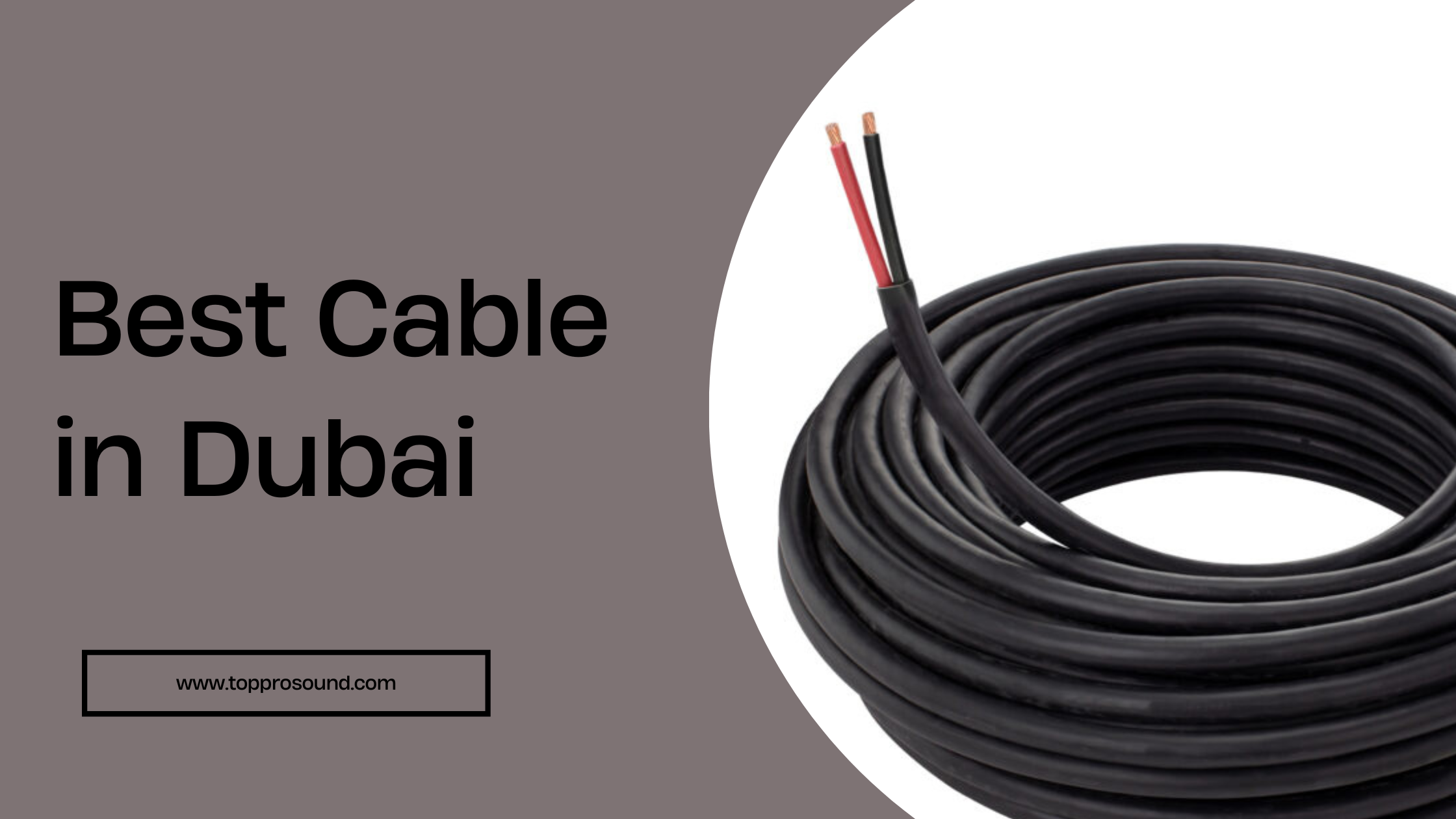Choose Your Best Microphone Cable in Dubai

Choose Your Best Microphone Cable in Dubai
Choosing the right cable for your microphone might seem like a small detail, but it plays a significant role in delivering clear and high-quality audio. Whether you’re a recording artist, podcaster, or live performer, the cable you use can make a big difference in your sound quality. That’s why we’ve created this guide – to help you navigate the world of microphone cables and make informed choices.
Purpose of the Guide:
This guide aims to simplify the often complex world of microphone cables. We’ll break down key concepts and terminology into easy-to-understand explanations, so you don’t need to be an audio engineer to make the right choice. Whether you’re setting up a home recording studio, preparing for a live gig, or simply looking to upgrade your existing microphone cable, we’ve got you covered.
Overview of the Cable Selection Process:
We’ll start by explaining the different types of microphone cables available, such as XLR, TRS, and TS cables. Understanding these basics is crucial for making the right decision. Then, we’ll help you assess your specific needs and requirements based on your microphone and setup. You’ll learn about factors like cable length, shielding, and connector types, all of which impact your audio quality. Finally, we’ll provide recommendations, tips, and troubleshooting advice to ensure that you choose and use the best cable for your microphone setup.
Let’s get started on your journey to improved audio quality!
Understanding Microphone Cables
Microphone cables make sure your voice or instrument’s sound reaches your recording equipment or audience intact. In this section, we’ll demystify microphone cables, keeping it simple and clear.
Types of Microphone Cables:
- XLR Cables: XLR cables are the go-to choice for many professionals. They’re sturdy, balanced, and ideal for long distances. If you’re serious about audio quality, XLR cables are a reliable bet.
- TRS Cables: TRS (Tip-Ring-Sleeve) cables are versatile and are often used in both balanced and unbalanced connections. They’re handy for studio setups and connecting various audio equipment.
- TS Cables: TS (Tip-Sleeve) cables are mostly used for unbalanced connections. These are common with instruments like guitars. Simple but effective.
The length of your cable matters. Longer cables can weaken your signal, leading to loss of audio quality. Shorter cables are generally better for maintaining signal integrity.
Assessing Your Microphone and Setup
Before you dive into the world of microphone cables, taking a moment to evaluate your specific microphone and setup needs can save you time and ensure a seamless audio experience.
Let’s break it down into simple steps:
- Know Your Microphone’s Connector Type: Begin by identifying the type of connector your microphone uses. This could be an XLR, TRS, or TS connector. Check your microphone’s manual or the connector on the microphone itself. Matching the right cable to your microphone’s connector is the first step towards clarity in your audio journey.
- Consider Cable Length Requirements: Determine how much cable length you need. Measure the distance between your microphone and your recording equipment or amplifier. It’s essential to have enough length without excessive slack, as longer cables can sometimes degrade your audio signal. Knowing your required cable length ensures a tidy and efficient setup.
- Analyze Your Recording Environment: Take a moment to assess your recording environment. Are you in a studio, a live performance space, or a home setting? Consider factors like potential sources of interference, such as power cables or electronic equipment. Understanding your recording environment helps you select the appropriate cable shielding and gauge to maintain the highest audio quality.
Criteria for Choosing the Best Cable for Your Microphone
When it comes to selecting the ideal microphone cable, several key factors come into play. This section breaks down the essential criteria in simple terms to help you make an informed decision:
Cable Type and Compatibility:
- Balanced vs. Unbalanced: Decide whether your setup requires a balanced or unbalanced cable. Balanced cables are preferred for long runs and critical audio applications due to their noise-reduction capabilities.
- XLR vs. TRS vs. TS: Choose the connector type that matches your microphone and equipment. XLR cables are standard for most microphones, while TRS and TS are used in specific situations. Ensure compatibility for seamless connectivity.
Consider the distance between your microphone and the recording device or amplifier. Select a cable length that comfortably covers this distance without excess slack. This prevents signal loss while maintaining a neat setup.
Shielding is crucial to minimize interference. Ensure your cable has adequate shielding, especially if you’re working in an environment with potential sources of electromagnetic interference, such as power cables or other electronics.
Opt for connectors made from robust materials that can withstand frequent use. High-quality connectors ensure a reliable connection, reducing the risk of signal interruptions during recording or performances.
Lastly, be mindful of your budget. There are microphone cables available to suit various price ranges. While quality often comes with a higher price tag, there are affordable options that offer decent performance for less demanding applications.
Microphone Applications and Cable Selection
Microphones serve various purposes, from capturing vocals in a studio to amplifying instruments on stage. Each application has unique requirements, and choosing the right microphone cable is essential to achieve optimal results. In this section, we’ll explore how different microphone applications impact cable selection, simplifying the process for you.
Studio recording demands pristine audio quality. In this controlled environment, XLR cables are often the preferred choice. They offer balanced connections, reducing interference and ensuring the clearest recordings for vocals and instruments.
Live performances come with their own set of challenges, including the need for durability and flexibility. TRS and TS cables are commonly used for connecting microphones to mixers and amplifiers. Selecting rugged, stage-worthy cables is crucial for reliability during live shows.
Podcasters and broadcasters require a mix of quality and convenience. XLR and TRS cables are suitable options, depending on the microphone and equipment used. Podcasters often value flexibility and portability, making cable length and connector compatibility crucial considerations.
Some microphone applications, such as Lavalier microphones for interviews or shotgun microphones for film production, have unique cable requirements. These may involve specialized connectors or cable types tailored to specific tasks.
Cable Maintenance and Care
Taking care of your microphone cable is essential to ensure longevity and reliable performance. In this section, we’ll cover the simple yet crucial steps to keep your cables in top shape.
– Treat your microphone cable with care. Avoid excessive bending, kinking, or stepping on the cable, as this can damage the internal wires. When coiling the cable, use the over-under technique to prevent twists and tangles. Store cables in a cool, dry place to avoid exposure to extreme temperatures or humidity.
– Regularly inspect your microphone cable for any visible damage or wear. Check the connectors for loose parts or bent pins. Cleaning connectors with isopropyl alcohol and a soft cloth can help maintain good electrical contact. Dust and dirt can accumulate on cables over time, so wipe them down with a clean, dry cloth to prevent interference.
– If you encounter issues like crackling sounds or signal loss, don’t panic. Troubleshooting can often resolve common cable problems. Start by checking for loose connections and making sure all connectors are securely plugged in. If you identify a damaged section of cable, consider repairing it with proper soldering techniques or seek professional assistance if needed.
Where to Buy Cables in Dubai?
Finding a reliable source for your microphone cables is crucial. Consider reputable audio equipment stores and online retailers. One such option is TopPro Sound, recognized as Dubai’s Best Leading Audio Shop. They offer a wide range of cables, ensuring you have access to quality options that suit your specific requirements.
Microphone cables come in various price ranges, depending on factors like length, cable type, and brand. While it’s tempting to opt for the cheapest option, investing in quality cables is often a wise choice. Quality cables typically range from affordable to premium, with mid-range options offering a good balance between performance and cost.
Troubleshooting Common Cable Issues
Encountering problems with your microphone cable can be frustrating, but many issues can be resolved with a bit of troubleshooting. In this section, we’ll address common cable problems and provide simple solutions.
- Cable Fraying and Damage:
– Issue: Over time, cables can become worn, leading to fraying or damage to the outer insulation.
– Solution: To prevent further damage, you can apply electrical tape to the affected area temporarily. However, it’s advisable to replace the cable eventually for safety and optimal performance.
- Signal Dropouts and Noise:
– Issue: Signal dropouts or unwanted noise in your audio can be caused by poor cable connections or interference.
– Solution: Start by checking all cable connections for looseness or corrosion. Clean connectors with isopropyl alcohol if needed. If interference persists, consider using shielded cables or relocating equipment away from potential sources of interference like power cables and electronic devices.
- Connector Problems:
– Issue: Connectors can sometimes become loose, resulting in intermittent or no signal.
– Solution: Ensure connectors are securely plugged in. If a connector is damaged or the pins are bent, consider repairing or replacing it. Regularly inspecting and maintaining connectors can prevent such issues.
FAQS
Does cable affect mic quality?
– Yes, the quality of the cable can affect microphone performance. A high-quality cable with proper shielding and connectors can help maintain sound quality and reduce interference.
What is the standard cable used for most microphones?
– The standard cable used for most microphones is the XLR cable. It is known for its balanced design and ability to transmit audio signals over longer distances while minimizing interference.
What is the most common microphone cable?
– The most common microphone cable is the XLR cable due to its widespread use in professional audio setups.
Does XLR cable affect sound quality?
– The XLR cable itself does not significantly affect sound quality when used correctly. It helps maintain sound quality by providing balanced connections that reduce interference over long cable runs.
What size is a microphone cable?
– Microphone cables are typically available in various lengths, commonly ranging from 3 feet (1 meter) to 25 feet (7.5 meters) or more. The size refers to the cable length.
Which cable is best for audio?
– The choice of cable depends on your specific audio needs. For professional audio applications, XLR cables are often considered the best choice due to their balanced design and interference reduction.
What is a microphone cable?
– A microphone cable is a specialized cable used to connect microphones to audio equipment such as mixers, amplifiers, or recording devices. It carries the audio signal from the microphone to the recording or amplification system.
Is XLR a microphone cable?
– XLR cables are commonly used as microphone cables due to their balanced design, but they can also be used for other audio equipment and applications.
Which cable is best for a microphone?
– The best cable for a microphone depends on your specific requirements and the equipment you are using. XLR cables are a popular and versatile choice for microphones, offering reliable audio quality and interference resistance. However,
Remember that while the cable may seem like a small component in your audio setup, its role in preserving sound quality is paramount. With the knowledge and guidelines provided in this guide, you’re well-equipped to make informed decisions and embark on a seamless audio experience.







